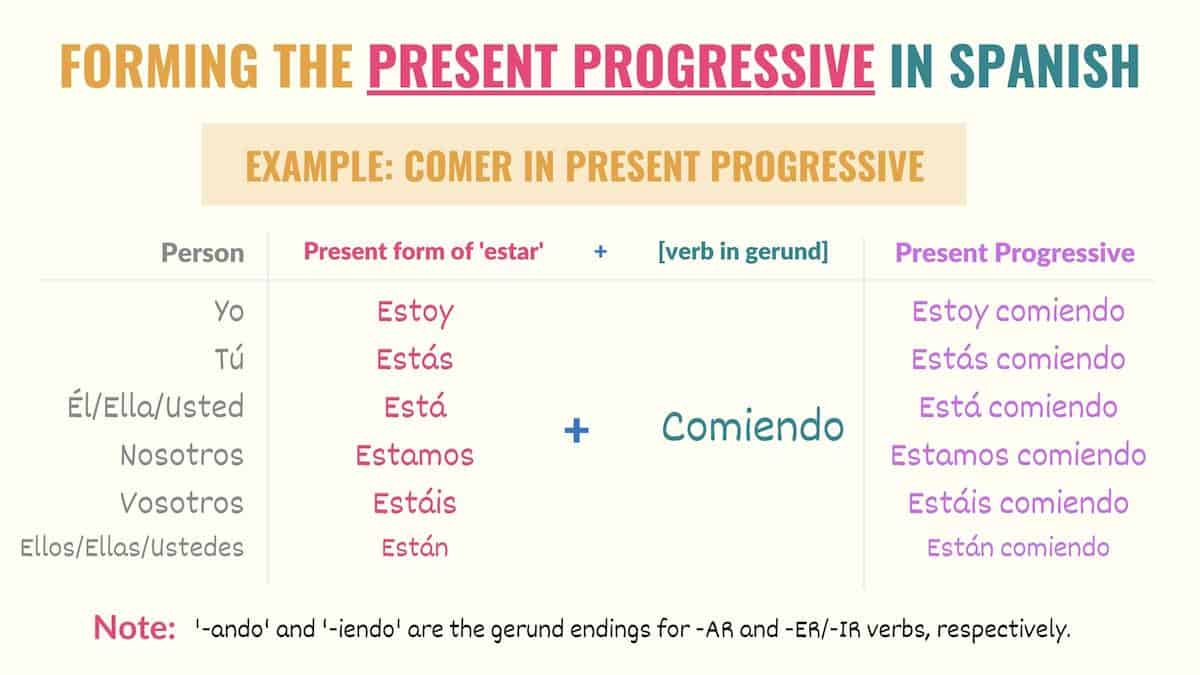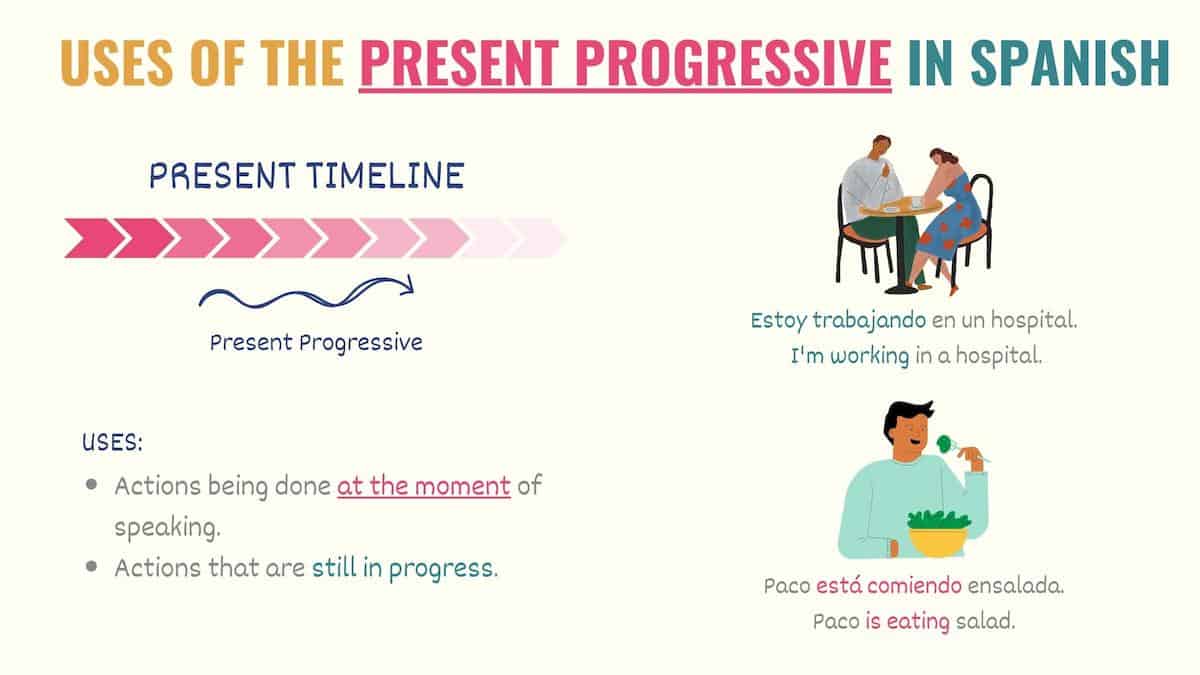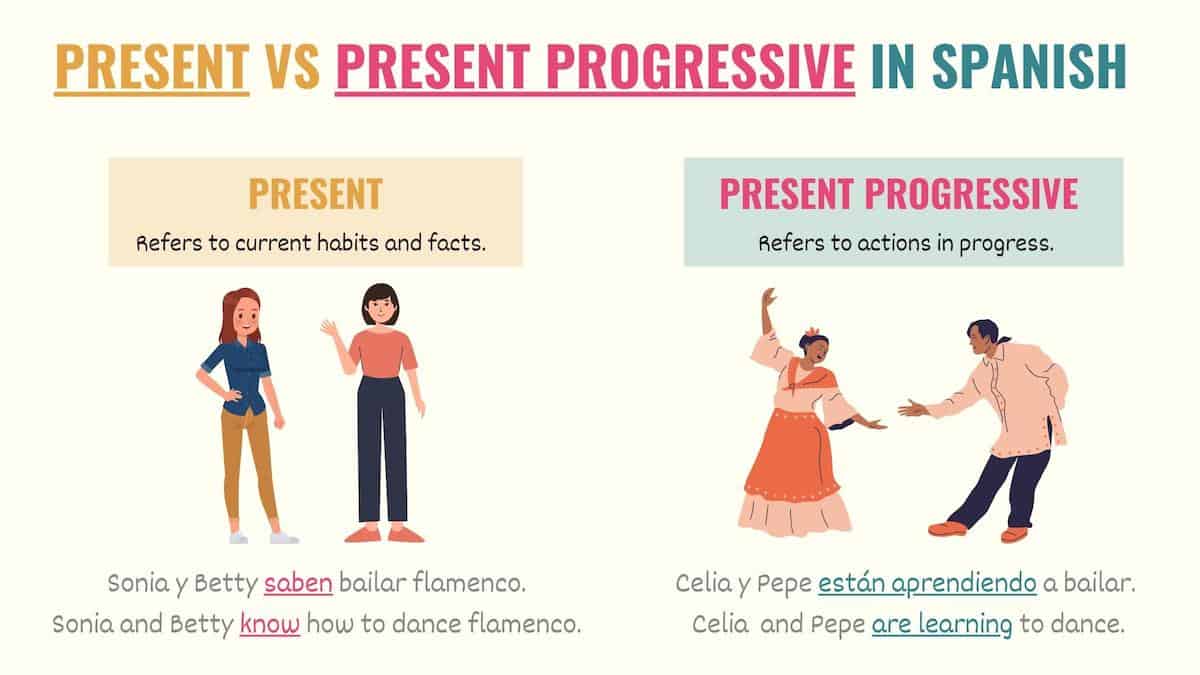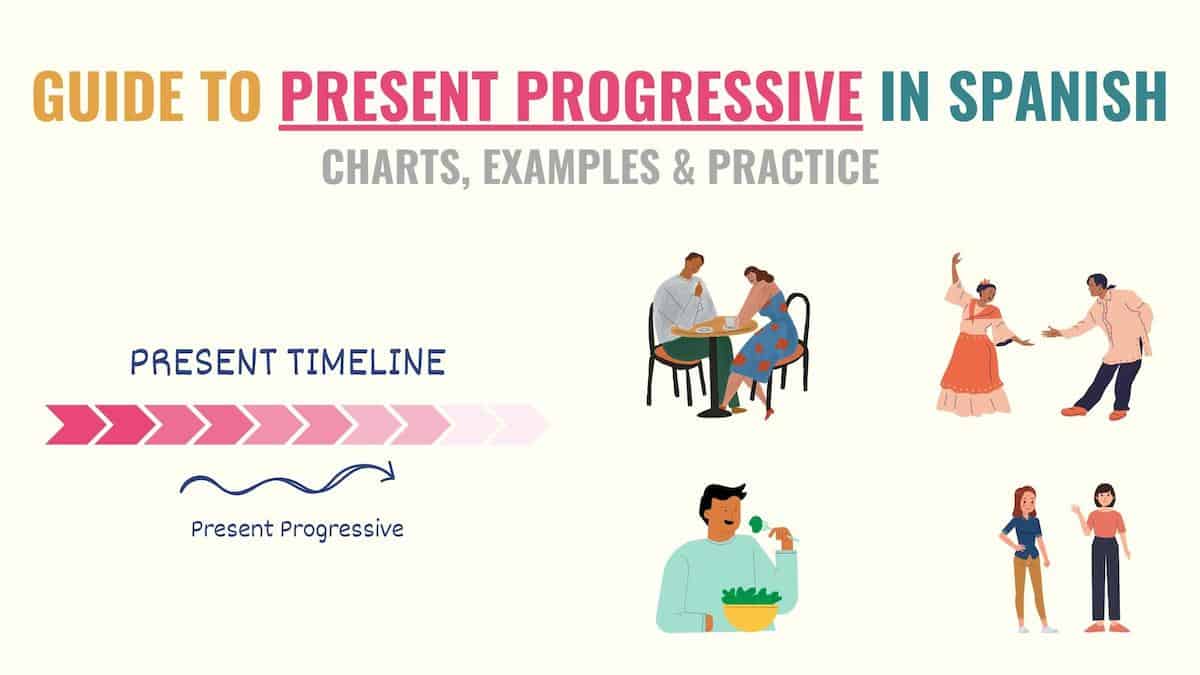The present progressive in Spanish is used to talk about actions in progress. Since this meaning can only be conveyed with this tense, you must learn how to use and form it.
As a result, in this guide, we’ll cover:
- Forming the Spanish Present Progressive
- When to Use the Present Progressive in Spanish
- Present Progressive vs Present Tense
- Key Points
- Practice Quiz
How to Conjugate the Present Progressive in Spanish
Estar + gerund (present participle) is the formula to conjugate the present progressive in Spanish. In other words, the present progressive is built using the present form of estar and a verb in gerund form.
Estar delivers information about the subject (the person performing the action). Here is a quick reminder of the present forms of ‘estar’:
- Yo estoy
- Tú estás
- Él / Ella / Usted está
- Nosotros estamos
- Vosotros estáis
- Ellos / Ellas / Ustedes están
The second part of the formula is a Spanish gerund, also known as present participle. Unlike the verb ‘estar’, which refers to the subject, the verb in gerund form describes the action being performed. To transform a regular verb into a gerund, you must add the following endings to the verb stem:
| Type of verb | Gerund ending |
|---|---|
| -AR verbs | -ando |
| -ER and -IR verbs | -iendo |
Below are some sentences with present progressive in Spanish so you can check how these elements work. These examples are using the verbs aprender, ayudar, and comer, so that you can see the present progressive tense applied to -AR, -ER, and -IR verbs.
[‘Estar’ present tense] + [verb in gerund]
¿Qué estás comiendo?
What are you eating?
Nosotros estamos aprendiendo español.
We are learning Spanish.
Paco me está ayudando con mi tarea.
Paco is helping me with my homework.
Take Note: Since it’s formed with two verbs, there are no endings for the present progressive. Instead, you must conjugate estar to the present simple tense and use a gerund.

Any irregularity in the Spanish present progressive is reflected in the gerund. In other words, irregular verbs in the present progressive are also irregular gerunds in Spanish.
Irregular verbs
As a quick overview, irregular gerunds are classified into two groups. The first is gerunds with stem-changes (‘o’ to ‘u’ and ‘e’ to ‘i’). For example:
- Dormir – Durmiendo
- Poder – Pudiendo
- Decir – Diciendo
- Sentir – Sintiendo
The second group uses the ending –yendo. This ending is applied to verbs whose stem ends with an ‘e’ or ‘i’, and it’s done to ease the pronunciation. For instance:
- Leer – Leyendo
- Ir – Yendo
- Construir – Construyendo
- Oír – Oyendo
Take Note: You will deal with stem-changing verbs in most Spanish tenses. To learn more about irregular gerunds, you can check my guide on Spanish gerunds.
Reflexive verbs and object pronouns in the present progressive
When using the present progressive in Spanish, you may need to work with a reflexive verb or a verb followed by an object pronoun. If this is the case, you only need to ensure to place the pronoun correctly.
With the Spanish present progressive, you can either:
- Place the reflexive or object pronoun before estar:
¿Quién se está bañando?
Who is showering?
¡Te estoy hablando!
I’m talking to you!
- Attach the reflexive or object pronoun to the end of the gerund verb:
¿Quién está bañándose?
Who is showering?
¡Estoy hablándote!
I’m talking to you!
Take Note: When attaching a pronoun to a gerund or infinitive verb, you must add an acute accent. This is because the structure and stress of the word have changed. So, based on the Spanish accent rules, these types of words must be accentuated.
When to Use the Present Progressive in Spanish
The present progressive in Spanish is used to talk about actions in progress. In other words, it refers to activities that are currently happening. Unlike English, the Spanish present progressive is not used to talk about future plans or arrangements.
As its name suggests, the present progressive refers to actions that are in progress. To put it in simple terms, this tense is used to talk about:
Use #1: Actions people are doing right now
El bebé está durmiendo en su cuna.
The baby is sleeping in his crib.
Ben y Allie están trabajando.
Ben and Allie are working.
Ahorita no puedo, estoy preparando la cena.
I can’t right now, I am preparing dinner.
In the examples above, it’s contextually clear that the subject is performing the action in that moment (as we speak, Ben and Allie are working).
Use #2: Long-term actions or activities that are still current at the moment of speaking
Tú estás aprendiendo español.
You are learning Spanish.
¿En dónde estás trabajando?
Where are you working?
¿Todavía estás buscando departamento?
Are you still looking for an apartment?
In this second set of present progressive examples expresses that the actions are in progress or are still current. By asking ¿en dónde estás trabajando?, I’m inquiring about your current job.

Take Note: It’s called present progressive because we’re using the present form of ‘estar’. However, there are also progressive tenses in the past and future. In such cases, you’ll use the past or future forms of ‘estar’.
Difference Between Present and Present Progressive in Spanish
Since they both refer to the present, some people assume that the simple present and present progressive in Spanish are interchangeable. However, these tenses convey different information.

The Spanish present provides information about current habits, facts, or qualities.
Jessica vive en España y tiene dos perros.
Jessica lives in Spain and has two dogs.
On the other hand, the present progressive in Spanish focuses on actions that are currently happening (actions in progress):
Jessica está paseando a sus perros.
Jessica is walking her dogs.
Understanding Using Present vs Present Progressive
While these two tenses often do express different information, you’ll find many contexts where they can be used at least somewhat interchangeably. Let’s break down the two above examples with Jessica:
- In Example #1, we could say either Jessica lives in Spain (Jessica vive en España) or Jessica is living in Spain (Jessica está viviendo en España). While both are correct, there’s a permanence to the present tense that isn’t necessarily true with the present progressive. If Jessica were living in Spain for a few years, the present progressive would be more accurate.
- In Example #2, the same rules would apply. Jessica is walking her dogs (Jessica está paseando a sus perros) is used when talking about the moment of speaking. In order to use the present tense, we would want to express details about this habit. For instance, Jessica walks her dogs in the evenings (Jessica pasea a sus perros en las tardes).
Key Points
The present progressive in Spanish is a basic and essential tense that native and fluent speakers use in their conversations on a daily basis. Here are the key points you should keep in mind:
- The Spanish present progressive refers to actions that:
- Are taking place at the moment of speaking.
- Are still current or in progress.
- Estar (present) + gerund is the formula to build the present progressive tense.
- ‘Estar’ delivers information about the subject while the gerund refers to the action.
- Spanish regular gerunds are formed with the following endings:
- –ando for -ar verbs.
- –iendo for -er and -ir verbs.
- Irregular gerunds will also be irregular verbs in the present progressive.
- Reflexive and object pronouns can be placed before ‘estar’ or attached to the gerund when using the Spanish present progressive tense.
Download the Spanish Present Progressive Cheat Sheets & Summary PDF
Please feel free to download a free copy of the cheat sheets, key points and rules all in PDF format to study later.
Practice Quiz: Present Progressive Tense Conjugation
Take the Present Progressive quiz which will test your conjugation skills with multiple choice questions for this tense.



